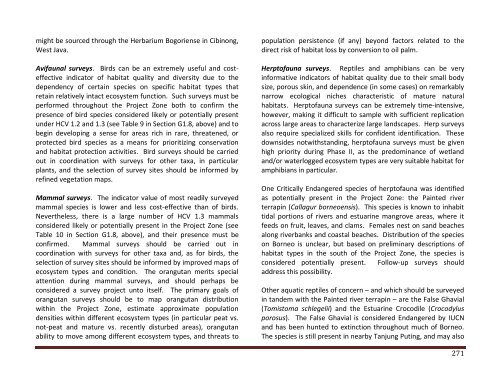The Rimba Raya Biodiversity Reserve REDD Project
The Rimba Raya Biodiversity Reserve REDD Project
The Rimba Raya Biodiversity Reserve REDD Project
Create successful ePaper yourself
Turn your PDF publications into a flip-book with our unique Google optimized e-Paper software.
might be sourced through the Herbarium Bogoriense in Cibinong,West Java.Avifaunal surveys. Birds can be an extremely useful and cost-effectiveindicator of habitat quality and diversity due to thedependency of certain species on specific habitat types thatretain relatively intact ecosystem function. Such surveys must beperformed throughout the <strong>Project</strong> Zone both to confirm thepresence of bird species considered likely or potentially presentunder HCV 1.2 and 1.3 (see Table 9 in Section G1.8, above) and tobegin developing a sense for areas rich in rare, threatened, orprotected bird species as a means for prioritizing conservationand habitat protection activities. Bird surveys should be carriedout in coordination with surveys for other taxa, in particularplants, and the selection of survey sites should be informed byrefined vegetation maps.Mammal surveys. <strong>The</strong> indicator value of most readily surveyedmammal species is lower and less cost-‐effective than of birds.Nevertheless, there is a large number of HCV 1.3 mammalsconsidered likely or potentially present in the <strong>Project</strong> Zone (seeTable 10 in Section G1.8, above), and their presence must beconfirmed. Mammal surveys should be carried out incoordination with surveys for other taxa and, as for birds, theselection of survey sites should be informed by improved maps ofecosystem types and condition. <strong>The</strong> orangutan merits specialattention during mammal surveys, and should perhaps beconsidered a survey project unto itself. <strong>The</strong> primary goals oforangutan surveys should be to map orangutan distributionwithin the <strong>Project</strong> Zone, estimate approximate populationdensities within different ecosystem types (in particular peat vs.not-‐peat and mature vs. recently disturbed areas), orangutanability to move among different ecosystem types, and threats topopulation persistence (if any) beyond factors related to thedirect risk of habitat loss by conversion to oil palm.Herptofauna surveys. Reptiles and amphibians can be veryinformative indicators of habitat quality due to their small bodysize, porous skin, and dependence (in some cases) on remarkablynarrow ecological niches characteristic of mature naturalhabitats. Herptofauna surveys can be extremely time-‐intensive,however, making it difficult to sample with sufficient replicationacross large areas to characterize large landscapes. Herp surveysalso require specialized skills for confident identification. <strong>The</strong>sedownsides notwithstanding, herptofauna surveys must be givenhigh priority during Phase II, as the predominance of wetlandand/or waterlogged ecosystem types are very suitable habitat foramphibians in particular.One Critically Endangered species of herptofauna was identifiedas potentially present in the <strong>Project</strong> Zone: the Painted riverterrapin (Callagur borneoensis). This species is known to inhabittidal portions of rivers and estuarine mangrove areas, where itfeeds on fruit, leaves, and clams. Females nest on sand beachesalong riverbanks and coastal beaches. Distribution of the specieson Borneo is unclear, but based on preliminary descriptions ofhabitat types in the south of the <strong>Project</strong> Zone, the species isconsidered potentially present. Follow-‐up surveys shouldaddress this possibility.Other aquatic reptiles of concern – and which should be surveyedin tandem with the Painted river terrapin – are the False Ghavial(Tomistoma schlegelii) and the Estuarine Crocodile (Crocodylusporosus). <strong>The</strong> False Ghavial is considered Endangered by IUCNand has been hunted to extinction throughout much of Borneo.<strong>The</strong> species is still present in nearby Tanjung Puting, and may also271
















